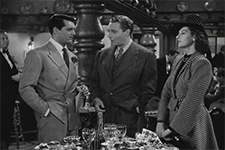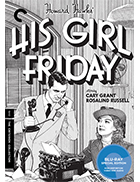His Girl Friday
|  Howard Hawks’s His Girl Friday, one of the fastest, funniest, and most honestly brutal comedies of the classical Hollywood era, was based on the deeply influential 1928 Broadway play The Front Page by Ben Hecht and Charles MacArthur, two former Chicago tabloid reporters. The play had been adapted to the screen nine years earlier by Lewis Milestone, with Adolphe Menjou and Pat O’Brien in the lead roles of Walter Burns, a relentless newspaper editor, and Hildy Johnson, his best reporter who wants to leave the newspaper racket to settle down with a nice girl. When Hawks set about making his version, he stumbled upon a simple, yet particularly brilliant change: making Hildy a woman, rather than a man (he didn’t even have to change the name). The idea came to him when he was reading the play aloud to prove the brilliance of its dialogue. He asked a girl to read Hildy’s part and discovered that, as he related to filmmaker Peter Bogdanovich, “Hell, it’s even better between a girl and a man than between two men” (changing the sex of a character when remaking an older film or adapting a play was actually somewhat common practice in the ’30s, but this is surely one of the most effective uses of this gambit). When Hawks turned the adaptation over to screenwriter Charles Lederer, who was a protégé of Ben Hecht’s and had written additional dialogue for Milestone’s version, he did Hawks’s idea one better by making Walter and Hildy ex-spouses, which gave an additional charge to their rapport and upped the comedic stakes of Walter trying to keep Hildy at the paper. Now it wasn’t just an issue of professionalism, but one of thwarted romance, albeit romance that is constantly undercut by the vigorous rush of the newspaper business and de-sentimentalized with caustic dialogue and sardonic antagonism. The final coup was the casting: Cary Grant, the dexterous grandee who had earlier starred in Hawks’s at-the-time derided screwball comedy Bringing Up Baby (1938) and his adventure-romance Only Angels Have Wings (1939), as Walter, and the whip-smart Rosalind Russell, who had spent most of the ’30s playing supporting roles and had recently discovered her chops as a comedian in George Cukor’s The Women (1939), as Hildy. Grant was already a star, and Russell, who took the role after it had been turned down by a roster of A-listers including Katherine Hepburn and Ginger Rogers, quickly became one. They have impeccable on-screen chemistry, and their rat-a-tat back-and-forths count as some of the great dialogue scenes in Hollywood cinema. The original play was renowned for its dialogue, and Grant and Russell chew it up and spit it out with superlative gusto, creating a machine-gun effect of overlapping point/counterpoint and the trading of barbs so wicked that half of them would fill another film entire. The publicity for His Girl Friday claimed that some scenes had dialogue running at speeds of up to 240 words per minute, but film scholar Lea Jacobs determined that that assessment was not entirely accurate—there are some portions of the film that pack in over 300 words per minute. The story unfolds over a couple of hours, starting with Hildy’s arrival at her old newspaper office to inform Walter that she is getting married to Bruce Baldwin (Ralph Bellamy), a nebbish insurance man who she believes is her ticket to a staid, normal life. Ready to board a 6:00 train with Bruce and his imperious mother (Alma Kruger), Hildy is drawn back into the world she is trying to leave behind when Walter convinces her via appeals to her inner professional and some outright fabrication that she must write a breaking story about a man who is about to hung for shooting a police officer. The man’s execution is key to the upcoming election of the mayor and the rest of his political machine, and Walter wants to throw a wrench in the works by creating sympathy for the condemned man via his newspaper. Make no mistake: Walter has no genuine intention to save the man or scrutinize the ethics of the death penalty; rather, he just wants to sell papers, beat the competition, and maybe steal Hildy back from a life he knows (and she will soon learn) is entirely ill-suited to her disposition. The second half of the film takes place almost entirely in the press room of the courthouse, where Hildy and Walter mix it up with various reporters while trying to keep Bruce and his mother at bay (the former winds up in jail twice and the latter is carted off by a mobster at one point to keep her quiet) and also hiding the condemned man, who escapes jail and winds up cowering inside a roll-top desk right there in the press room. The economy of storytelling is amazing, as Hawks and Lederer, following the play’s rapid-fire template, pile action on top of action, all of which is laced with withering, nonstop dialogue that has to be appreciated as one continuous flow of brilliant verbiage. His Girl Friday is a compulsively rewatchable film if only because it takes literally dozens of viewings to catch every nuance of every line that flies through it. Hawks was already a master of directing actors and managing complex dialogue, which he had demonstrated in his earlier farces like Twentieth Century (1936) and Bringing Up Baby, but there is something particularly exhilarating about his work here. He remains a quintessentially unobtrusive director, whose classical style elevates every aspect of the film without drawing attention to itself as style. Repeat viewing attest to the dexterity of his approach, as he incorporates long takes, rapid montages, complex staging and blocking, fluid camera movements, static camera placement, close-ups and deep space with equal mastery. There is literally nothing that is not in the film, yet it all flows together seamlessly—a master class in classical Hollywood storytelling. Interestingly, His Girl Friday was not widely mentioned during the French-led canonization of Hawks as a great artist, rather than just a Hollywood craftsman, in the 1950s and ’60s (in his 1953 appreciation “The Genius of Howard Hawks,” published in Cahiers du cinéma, Jacques Rivette doesn’t even mention it once). The film’s resurgent popularity came about in the 1970s, a period when classical Hollywood cinema was gaining new appreciation through the work of film critics like Pauline Kael and Andrew Sarris, the emergence of film studies departments at major universities, and the films of New Hollywood auteurs like Martin Scorsese and Steven Spielberg. And it was all due to the fact that Columbia Pictures failed to renew the copyright, which sent the film spiraling into the public domain, making it a popular item in 16mm sale and rental catalogs because it was cheap. However, there is nothing “cheap” about the film, as it transcends almost every barrier that could possibly be erected, cutting through easy sentimentality with its razor sharp wit and irreverent sense of humor, avoiding easy cynicism with its carefully calibrated streaks of idealism (it does ultimately hold up the press, filled as it may be with scoundrels and exploiters, as a necessary watchdog on crooked politicians—which means that Donald Trump probably hates it), and pushing just about every pleasure button the movies have to offer. It celebrates, like so many Hawks films, the importance of professionalism and one’s duty to carry through with it, while taking down the pretentious, the officious, and the corrupt (well, the unlikeable corrupt, anyway). It is timeless in all the best ways.
Copyright © 2017 James Kendrick Thoughts? E-mail James Kendrick All images copyright © The Criterion Collection / Sony Pictures Home Entertainment | |||||||||||||||||||||||||||||||||||
Overall Rating: 


 (4)
(4)


